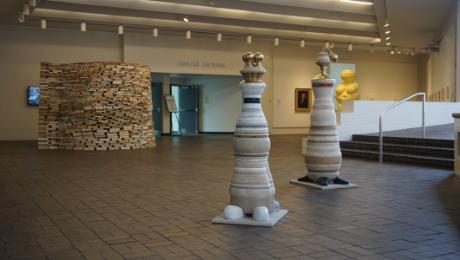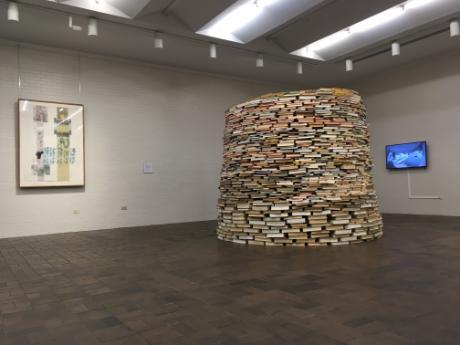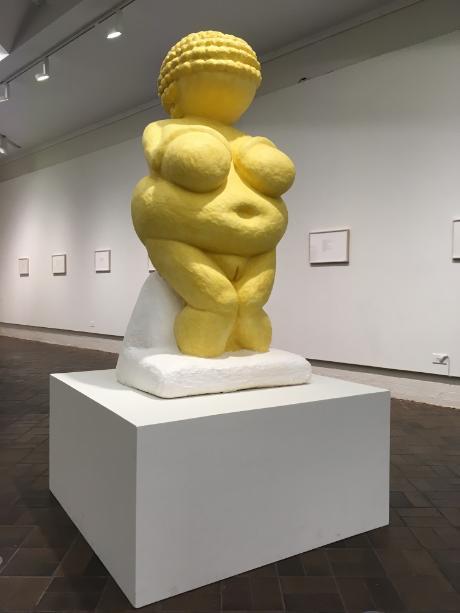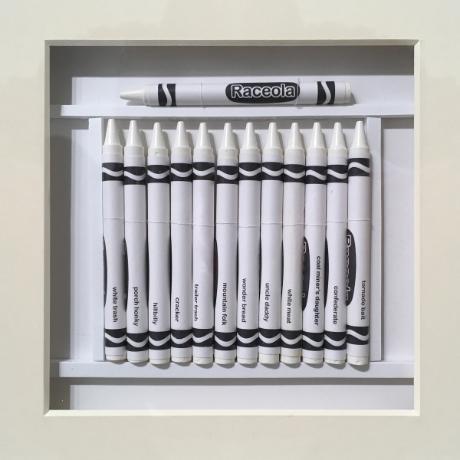The Particular Past

Image: unauthorized copy of Gilbert Stuart's portrait of Washington Foeiqua [Chinese], 1800 - 1805, Reverse painting on glass. From Muhlenberg's Florence Foerderer Tonner Collection
Martin Art Gallery: The Particular Past, In the Galleria Space: 2.14 – 5.20, Opening Reception 2.14 5 – 6:30pm
Featuring works from the collection, and works by Tom Bendtsen, Foeiqua, Sharka Hyland, Andrew E. Johnson, Bang Geul Han, Donald Porcaro, Jessica Posner, Jessica Walker, curated by Martin Art Gallery Director Paul M. Nicholson
The Particular Past explores the spaces between knowledge and belief. By rewriting and reimagining past and present, these artists embody our political and cultural moment where expertise, truth, and even the past are malleable. Shifting between witness and advocate, these artists alternately illuminate and gaslight their way through a conversation on the value of knowledge.
We are in a time where ideology trumps truth, all evidence is suspect, and social and institutional trust seem like notions of the past. In this moment of seemingly capricious truth, The Particular Past does not acquiesce and ebb toward postmodernity, but embraces open discussion. Artists in this exhibition demonstrate the tension between deities and defiance through objects, ideas, and experiences helps us come to terms with this moment of radical social and political change. In an effort to understand this epic shift in ho we see the world, this exhibition functions as an act of collective introspection.
Jessica Walker and Jessica Posner interrogate historical narratives through a subversive cultural lens, employing stereotypes to survey the body politic. Layered constructions by Tom Bendtsen and Donald Porcaro intermingle foundations of knowledge with the fundamentals of civilization. Manicured forms create structures that act as architectonic talismans of paper and stone.
Sharka Hyland presents visions of America through pencil drawings that explore how literary language transcends the distinction between the verbal and the visual. Bang Geul Han projects a more jarring reality through her 2017 piece Through the Gaps Between My Teeth, which deconstructs the transcript from President Trump’s Access Hollywood tape, using his transgressive words in a generative animation that reassembles the text to form accounts of sexual assault posted on Twitter.
Andrew Ellis Johnson’s Strewn shows pigs in a field of books, rooting around, eating, lounging in a muddy library. Johnson notes about this piece that “In fiction, swine have acted as agents of both revolution and repression; in reality, they have been agents of anti-intellectualism. During Pol Pot’s regime in Cambodia, the National Library was used as a stable and piggery. Its books fueled cooking fires, their pages rolled for cigarette papers. … The uneducated were glorified - as they are in other countries today.”
Works in The Particular Past question the broader implications of our actions and attitudes toward truth and justice. Looking to the past for inspiration, these artists work within a critical framework that aspires to an ethical, just, and self-aware humanism rooted in democratic principles.
Click here to see the Morning Call's exhibition review of the Particular Past
Artist Bios:
Tom Bendtsen was born in Copenhagen Denmark, raised in Canada. He did his undergraduate work at OCAD in Toronto, before completing an MFA at SUNY Buffalo in 2003. He has exhibited his works at the Albright-Knox gallery in Buffalo, N.Y., Grounds for Sculpture in Hamilton N.J., Southern Alberta Art gallery in Lethbridge, The Rooms in St Johns NFLD, OpenSpace in Victoria B.C. Canada. He has also exhibited at the Koffler Gallery, Mercer Union, and has contributed to a variety of self generated exhibitions in the Toronto area. He was a featured artist at Toronto’s 2008 Nuit Blanche and 2009 Luminato festivals of contemporary art. His films have been widely screened in Europe, Canada and the USA. He has also received grants from the Toronto; Ontario and Canada council for the Arts and in 2006 was awarded a Chalmers Art Fellowship. He is currently lives and works in Philadelphia.
Bang Geul Han’s work has recently been exhibited as part of Bronx Calling: The Fourth Aim Biennial at the Bronx Museum of Arts, NYC; Queens International 2016 at Queens Museum, NYC; and Play: Power at the Pulse Contemporary Art Fair in Miami, FL. Han is the recipient of numerous artist residencies and fellowships including the Lower Manhattan Cultural Council’s Workspace program (2011-2012), MacDowell Colony (2009) and Skowhegan School of Painting and Sculpture (2007). Han is the 2017-2018 Visual Artist Fellow at the Center for the Emerging Visual Artists in Philadelphia, PA. Han holds an MFA in Electronic Integrated Art from Alfred University and BFA in Painting from Seoul National University in Seoul, Korea. She lives and works in New York City.
Sharka Hyland’s recent solo exhibitions include Musik: Atem der Statuen at Galerie Dittmar, Berlin, Germany, Les Phares at The American Gallery, Marseille, France, and “this thing we call a city” at Gallery Joe, Philadelphia, PA. Her work is currently on view in Buchwelten at Altana Foundation, Bad Homburg, Germany and in PaarWeise at Galerie Martin Kudlek, Cologne, Germany. Hyland is a 2015 Bader Fund Grantee for her project on David Foster Wallace. In the same year she was a Civitella Ranieri Visual Arts Fellow in Umbria, Italy.
Hyland received her MFA from Yale University School of Art in graphic design (1988). She studied art history at École du Louvre, Paris (1992) and comparative literature at Albert-Ludwig University, Freiburg, Germany (1983). Born in 1954 in Czechoslovakia, Hyland immigrated to the US in 1984, and lives and works in Philadelphia.
Don Porcaro is a New York-based sculptor whose work explores the nature of human interaction with the physical world through architecture and man-made objects like tools and toys. His work has been exhibited nationally and internationally, and has been reviewed in The New York Times, Sculpture Magazine, Art in America, Artnews, BOMB and Newsday, among others. In 2007 he was the subject of a featured profile in Sculpture magazine, and in 2011 was the U.S. representative at the 50th Forma Viva International Sculpture Symposium in Portoroz, Slovenia. He was nominated in 2013 for the International Sculpture Center’s prestigious Educator of the Year Award, and is the recipient of a 1991 Teaching Excellence Award from Parsons the New School for Design, where he has been a professor of Fine Arts since 1986. Porcaro received his MFA in Sculpture from Columbia University.
Jessica Posner (b. 1985, Boynton Beach, FL, USA) is a feminist, multidisciplinary artist, writer, and healer. She weaves together humor, poetic devices, and sociopolitical context through absurd, poignant works that model emotionally honest, non-judgmental, and resilient relationships to our bodies, language, and presence. Recent exhibitions, performances, and screenings include the Everson Museum of Art (Syracuse, NY), Leslie-Lohman Museum of Gay and Lesbian Art PSPS (NYC), La Mama Galleria (NYC), Movement Research at Judson Church (NYC), Yale School of Art (Hartford, CT), Alfred University (Alfred, NY), and PULSE PLAY Miami Beach (Miami, FL). In 2017, Posner was an Artist-in-Residence for the Everson Museum of Art’s “Seen & Heard: An Active Commemoration of Women’s Suffrage” exhibition, for which she produced the VENUS butter sculpture. Her 40-minute experimental performance film BUTTER BODY POLITIC (2017)—which culminates four years of Posner's performance-based research into butter as a metaphor for a delicious, slippery, fat, feminist, queer, resilient body politic—received a 2016 CNY Arts Individual Artist Commission, a regrant program of the New York State Council on the Arts (NYSCA) administered by CNY Arts.
Posner received an MFA in Fine Arts from Parsons The New School for Design in 2013. She currently lives and works in Syracuse, NY where she teaches art and writing as a Humanities Faculty Fellow at Syracuse University and Lecturer at Colgate University.
Andrew Ellis Johnson’s work has appeared in galleries, festivals, public collaborations, conferences, and publications in the Americas, Europe, Asia and the Middle East. He has performed as co-founder of the collective PED in Buffalo, Belfast, Chongqing, Rio de Janeiro, St. John’s, and Toronto. Residencies and exchanges over the last decade include those at: Korean National University of the Arts, Seoul; Blue Mountain Center, New York; University of the Arts London, Camberwell; Fayoum International Art Center, Egypt; and Sites of Passage in Jerusalem/Ramallah/ Pittsburgh. He studied at the School of the Art Institute of Chicago (BFA) and Carnegie Mellon University (MFA) in Pittsburgh, where he is Associate Professor of Art.
Jessica Walker is a multidisciplinary artist from Virginia who lives and works in Brooklyn. Her Appalachian upbringing is the focus of recent work through which she interrogates white racial stereotypes. She received her BA in Art History from the University of Virginia and her MFA in Conceptual Information Arts from San Francisco State University. She is an Assistant Professor at Parsons School of Design in New York.
|
Donald Porcaro |
Donald Porcaro |
Don Porcaro synthesizes form and content in his Talisman series (2012 – present), where deposits of shaped stone and brass form enigmatic sentinels. The incised and stacked rock strata results in something that is both familiar but mysterious. Porcaro’s stylized forms, complete with feet, a “body”, and topped with an array of polished brass of uncertain utility result in something the feels like a combination of history and culture. Employing rock formed over millennia, then shaped into a ritualistic monument, the artist forces us to contemplate whether this is a credible historical artifact or a new article capable of divination.Layered constructions by Tom Bendtsen and Donald Porcaro intermingle foundations of knowledge with the fundamentals of civilization. Manicured forms create structures that act as architectonic talismans of paper and stone.
Left: Robert Rauschenberg (1925 – 2008)
Mock Pollen, 1979
Solvent print on canvas
Martin Art Gallery, Gift of Dr. Barry Altman, class of ‘54
Center: Tom Bendtsen
Conversation #6, 2018
8332 books, coal, mushrooms
Right: Andrew Ellis Johnson
STREWN, 2015,
HD Video, 5:02 minutes
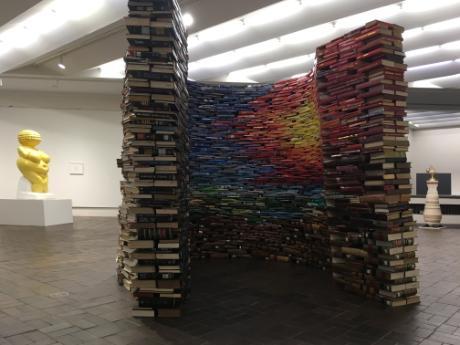
Tom Bendtsen
Conversation #6, 2018
8332 books, coal, mushrooms
In his earlier Argument series (1995 – 2003), Bendtsen combined form and order through architectonic book stacking to create monuments to arguments. Arguments employed obsessive ordering by subject, as history was indexed spatially.
In his more recent Conversations (2004 – present), structures have focused on surface image, disregarding subject. TheseConversations use book spine color as physical pixel to focus on over-all image. Indexing by color creates unexpected connections between books, as subject and title is left to chance. A detective novel abuts a text on accounting, sharing onlycover color in common. These radical juxtapositions make for a kind of three-dimensional flarf poetry. In Bendtsen’s work however, there is no cutting or pasting, as books are stacked without adhesive, bound together only by gravity. Tomes become an essential building block; that his structures are unsecured makes them inherently fragile, preserving the potential for collapse.
Jessica Posner
VENUS, 2017
Butter and beeswax over
carved, plastered foam form
Posner’s VENUS uses the The Venus of Willendorf (an 11.1-centimeter-tall Venus figurine est. 28,000 - 25,000 BCE.) as a point of departure to discuss contemporary issues of body image, acceptance, and objectification of women. Taking this Paleolithic sculpture and its anthropological and art historical significance into account, Posner uses butter as a metaphor for the body politic. Posner createdVENUS in 2017 as a part of a larger series exploring structural violence against feminine subjects.
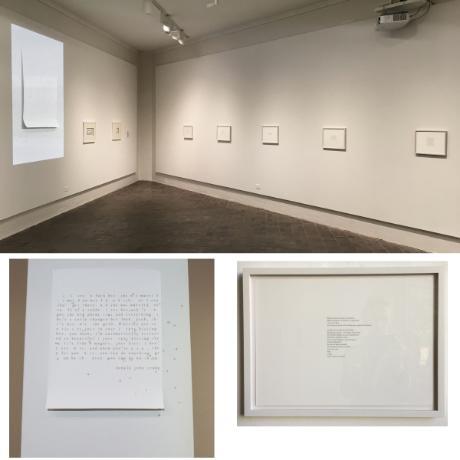
Left: Bang Geul Han
Through the Gaps Between My Teeth, 2017
Generative animation
Right: Sharka Hyland
Hand drawn pencil on prepared paper
12x18 inches,
Courtesy of the artist and Gallery Joe
Hyland’s drawings present visions of America— the land as well as the idea. In texts spanning a century and a half, American writers encounter the American landscape as a spiritual presence.Sharka Hyland and Bang Geul Han’s pieces share a unique engagement with text and language, but stand in stark contrast to one another. Hyland’s meticulously rendered hand-drawn text explores visions of America that are are open-ended, uplifting and optimistic. In contrast, Han’s projected text algorithm facilitates our collective recall of a public injustice.
Hyland is interested in how literary language transcends the distinction between the verbal and the visual. Many of the images we remember have no physical existence. They are evoked by the words of great writers and created in our mind as we read. Each image is unique, brought into being as we integrate the author’s words into our individual life experience. These complex images exist only in the reader’s mind; the text is their only material form. Hyland’s hand drawn texts use historically and culturally appropriate typefaces, in a size and format one might encounter while reading a book. The conjured image is the subject of the drawing.3
3. Text provided by the artist,
works lent courtesy of the artist and Gallery Joe
Han's generative animation deconstructs the letters constituting the transcript of President Trump’s Access Hollywood tape and briefly reassembles the letters to form accounts of sexual assault posted on Twitter. The deliberate limitation (every Tweet has to be reconstructed using only the letters in D.J.T.’s remarks) leaves imperfections in the text, alluding to the cultural and structural constraints involved in speaking on such subject matter. 4
This dystopian call and response played out publicly on social media in the waning months before the 2016 election. With digital memory standing in for corporeal memory, Han evokes the collective re- traumatization that occurs when we fail to hold the powerful accountable for their many transgressions.
Jessica Walker
The White Crayon, 2008
Wax crayons, paper labels, ed. of 3
Walker uses the dark history of Crayola’s infamous “Flesh”1 colored crayon as a point of departure for her colorful and provocative workThe White Crayon (2008). Her piece explores stereotypes, labels, and personal and institutional power using the parody brand, Raceola. In this alternate universe, white crayons are given color names based on derogative slang for poor or rural Caucasian [white] communities. Keeping her intention deliberately ambiguous, Walker anticipates the inflammatory All Lives Matter response to the Black Lives Matter movement, where questions of compassion and oppressed/oppressor are ironically inverted and tried in the court of public opinion. Owing to her upbringing in rural Virginia, Walker treads a fine line in this questionably sympathetic portrayal of the struggles that economically left behind communities endure.
1. Edwin Binney and C. Harold Smith Crayola company produced
their “Flesh Tint” crayon from 1903 – 1949, and as "Flesh" from
1949–1956, and 1958–1962; this line is now produced under the
color name “peach”.
